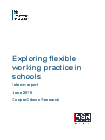Exploring flexible working practice in schools

The Department for Education (@EducationGovUK) has committed to promoting flexible working within schools. The Teacher Recruitment and Retention Strategy (January, 2019) reinforced DfE’s commitment to support schools to implement flexible working to attract more people to the profession, retain them in teaching, and encourage more returners and career changers to teaching.
To support that work, CooperGibson Research (CGR) was commissioned to conduct research to gather evidence on staff experiences (in particular, teachers and senior leaders) of flexible working in schools and ways in which these practices may be implemented and managed effectively.
Throughout all stages of this research, one of the clearest determining factors for the success of flexible working in a school was the attitude and approach taken by senior leaders towards flexible working, and their level of commitment to making it work. Thus, senior leaders being open and willing to consider different flexible working options was consistently identified as being fundamental to their successful implementation across a school’s workforce. This included acceptance among governors and executive leaders of academy trusts (as well as senior leaders) that flexible working was possible, in some form, for all staff types, including those in leadership positions.
Secondary senior leader, academy school, said: ‘I have worked in other schools and [flexible working] is non-existent. A flexible working culture comes from the head and their willingness to support their staff. We have formalised what was there before. The school has a family ethos and the school can see [the headteacher] leading by example with how the SLT work. Staff value that.’
Although many senior leaders participating in this project regarded themselves as being open to flexible working, 54 in the interviews they often added caveats that they would only consider these practices for non-teaching roles, staff members without leadership responsibilities, or for a limited number of staff only.
Reflecting this, ‘flexible hiring’ was generally not a standard offer that senior leaders used in recruitment drives. This indicated some ambivalence towards flexible working among senior leaders, and limited awareness as to the potential recruitment benefits. Indeed, where ‘flexible hiring’ was used by schools in the pilot studies, senior leaders noted an improvement in the range and quality of candidates applying for roles.
As the sample of interview participants focused on schools where flexible working was already in place, many examples were provided of how these arrangements were being implemented and managed practically in schools, across a wide range of staff and at all levels of leadership (see section 4).
Overall, teachers felt that their schools had supported their requests for flexible working wherever possible. Some were mindful of the potential negative impact on colleagues or pupils of flexible working arrangements, but it was senior leaders rather than teachers who most commonly reported these challenges (see section 3).
Findings from a four-stage survey of teachers and senior leaders exploring flexible working practice in schools.
Documents

Exploring flexible working practice in schools: final report
Ref: ISBN 978-1-83870-115-4, DFE-RR1083PDF, 1.22MB, 66 pages

Exploring flexible working practice in schools: pilot school summaries
Ref: ISBN 978-1-83870-116-1, DFE-RR1083PDF, 358KB, 25 pages

Exploring flexible working practice in schools: research appendix
Ref: ISBN 978-1-83870-117-8, DFE-RR1083PDF, 438KB, 28 pages

Exploring flexible working practices in schools: literature review
Ref: ISBN 978-1-78105-975-3, DFE-RR862PDF, 1.13MB, 82 pages

Exploring flexible working practice in schools: interim report
Ref: ISBN 978-1-83870-012-6 , DFE-RR913PDF, 1.32MB, 76 pages
Details
This mixed-methods research project presents information on:
- the uptake of flexible working in schools
- the benefits and challenges of flexible working
- ‘what works’ to effectively embed flexible working practices in schools
These findings are from 2018 to 2019, prior to the coronavirus (COVID-19) outbreak.
Published 21 June 2019
Last updated 26 November 2020 + show all updates
-
Added final report, pilot school summaries report, research appendix, and the previously published literature review.
-
First published.












Responses